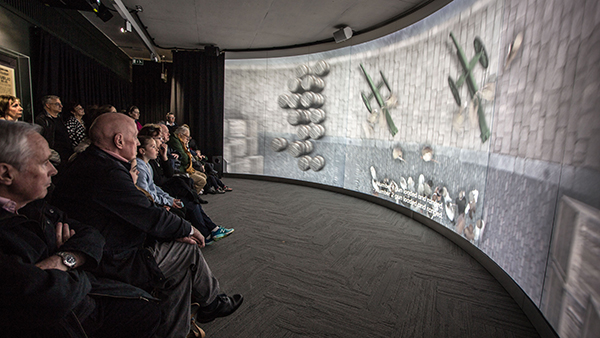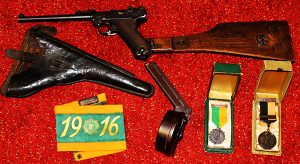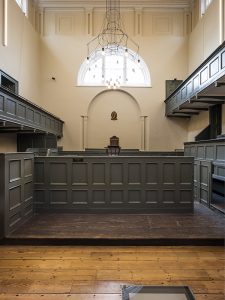MUSEUM EYE: 1916 exhibitions
Published in Issue 4 (July/August 2016), Reviews, Volume 24GPO Witness History
O’Connell Street, www.gpowitnesshistory.ie
Revolution 1916
Ambassador Theatre, Parnell Square, www.revolution1916.ie
Kilmainham Gaol Museum
www.kilmainhamgaolmuseum.ie
By Tony Canavan
The new permanent exhibition at the GPO certainly shows all the signs of the millions of euro spent on it. It is visually impressive, with its recreation of the post office as it would have looked in 1916, information panels, artefacts (many of them reconstructions) and many lively screens throughout.The centrepiece is the video presentation of the 1916 Rising. This consists of a curved video wall depicting events in Dublin from the viewpoint of the Rising’s leaders in the GPO and their opposite numbers in the British Army in their HQ. While some of the acting is a bit hammy, the visual effects are top-notch and give a real feeling not just for what was happening on the ground but also, with the imaginative use of animated maps, how it played out across the city.

Above: The centrepiece of the GPO exhibition is the video presentation on a curved video wall. (GPO Witness History)
The exhibition is also audibly impressive—but not, however, in a good way. There are a number of booths along one side in which videos of historians and journalists discussing the 1916 Rising run in a loop. On the day I was there, three guided tours, mostly of noisy school students, were being shown around, with each guide talking louder and louder to compete with the background noise.The exhibition is balanced in reflecting different views of the Rising, but the sense that this was a pivotal moment in Irish history is lost in the sensory overload. The events of Easter 1916 are presented as an exciting ‘show’ but one that fails to capture the significance of a group of patriots daring to take on the British Empire.That said, I would still recommend it. The reconstructions and original artefacts—guns, uniforms, documents and personal mementos—are all worth going to see and it is probably the most theatrical presentation of the Rising.
Situated in the old Ambassador Theatre, which as the Rotunda is where the Irish Volunteers were officially formed in November 1913, Revolution 1916 has none of the razzmatazz of the GPO’s exhibition but a lot of work has clearly gone into it. The main area upstairs has a large number of original artefacts on display from the Volunteers and the Rising, such as uniforms, weapons, documents, badges and other mementos of those involved. There are plenty of information panels, an introductory video, and paintings by Brian Mulvey illustrating aspects of this historical period, while the uniformed actors add to the atmosphere and are happy to answer questions.

Above: Some of the artefacts on display in Revolution 1916 in the Rotunda—German artillery Luger pistol given to Irish Volunteers in 1915 by a U-boat captain, with stock handle, holster and a 50-round trammel magazine; 1916 armband and medals. (All Irish Volunteers Commemorative Organisation Collection/Bartle D’Arcy)
Panels outlining the course of events daybyday smoothly guide the visitor through the exhibition. Noticeable is the focus on women. As the text explains, because the 1966 commemorations ignored women, the organisers of this one felt it important to highlight their role, and this it does very well,honouring many ‘ordinary’ women who played heroic parts alongside famous names like Constance Markievicz and Winifred Carney.
Downstairs are imaginative reconstructions of the GPO as it was in 1916, the route into Moore Street that the rebels used to escape the burning GPO, cells in Kilmainham Gaol and its stonebreakers’ yard, where the executions took place. The visitor is able to walk through all this while a soundtrack recreates the noises and voices of that week. Beyond the stonebreakers’ yard, the exhibition continues with the story of the War of Independence. Here, too, are original artefacts from the period, most noticeably two Thompson submachine-guns and a car used by Michael Collins. Perhaps controversially, the exhibition ends with a display devoted to IRA members who died on hunger strike in the more recent Troubles, establishing a claim of continuity with the IRA that fought the War of Independence.

Above: The interior of Kilmainham courthouse, next door to the gaol, which has now been transformed into a visitor centre. (OPW)
Kilmainham Gaol has long been a part of Irish history and has been open to the public as a museum for many decades. The main building has had some restoration work for the 1916 centenary but it already adequately reflected that aspect of its past (see Museum Eye, HI 16.6, Nov./Dec. 2008). Given the year that is in it, however, it becomes even more poignant to see cells where prisoners were held or to stand in the stonebreakers’ yard where fourteen leaders of the Rising were executed.
In preparation for the centenary, the courthouse, which is next door to the gaol, was transformed into a visitor centre, one of the ‘permanent reminders’ included in the official 1916 programme. The Courts Service handed over the building to the Office of Public Works, which carried out the work.The building, which dates from 1820, still retains its character as a courthouse from the nineteenth century but manages to successfully include state-of-the-art exhibitions, a café and bookshop.On display are artefacts associated with the Rising, such as a cross made by an internee at Frangoch, and digitised records of the court, as well as photographs and information panels. The centre also has the added advantage of enabling the gaol to better manage the flow of the 330,000 visitors who come each year.
Tony Canavan is editor of Books Ireland.
















